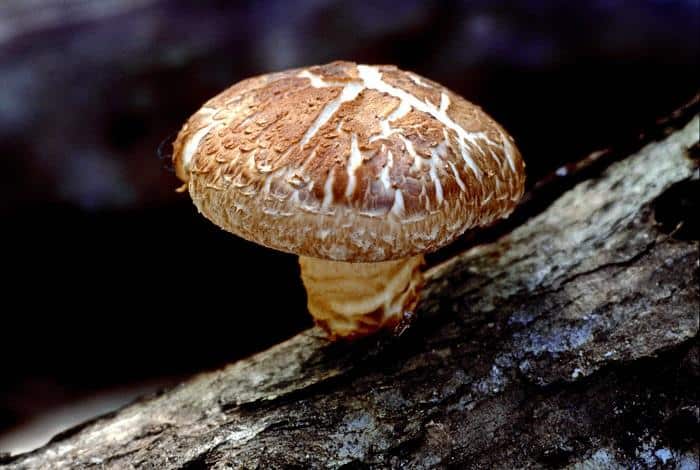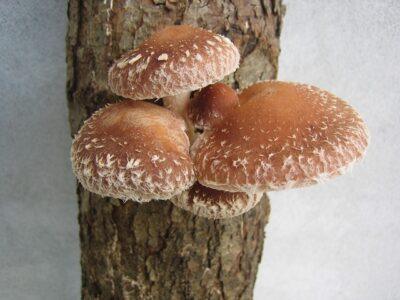Shiitake mushrooms are a wonderful addition to the homestead, serving as a valuable source of proteins and minerals — yet their nutritional value goes unnoticed by most. Just one average size shiitake mushroom has almost half a gram of protein! (The dietary recommendation is 0.8 grams/kg of weight.)
Shiitake mushrooms provide considerable health benefits to any food plan with a minimal amount of work to grow them, and can be grown in as little as seven days. A small space serves just as well as a large space, but the right conditions are essential in terms of temperature, light and humidity. For a more natural process, hardwood logs are the best option. For a faster and higher production process, use synthetic logs.
Hardwood logs can be found at a local resource such as a tree trimming service or logger. For those fortunate enough to have a chunk of land with woods, just use hardwood from home. It’s best to cut logs in early spring before the trees bud. They may be cut in the winter and stored until spring to inoculate. Oak is the premium choice of wood for growing shiitake mushrooms. Following is a list of woods that can be used, listed from best to worst:
- Oak
- Sugar
- Iron Wood
- American Hornbeam
- Beech
- Birch
- Hickory
- Red Maple
Once the logs are cut, be careful to keep the bark as undamaged as possible. They should be 3-4 feet long and 4-6 inches in diameter. Consider making the thicker logs shorter because they will be heavier. Logs will need to be soaked periodically, so the length of the logs may be dependent on what you will soak them in.
Learn 1,147 Secrets Of Successful Off-Grid Living! [2]
There are many perspectives on when to inoculate the mushroom logs after cutting. Trees do have a chemical in them to fight fungus from growing on them that can last about a week after cutting. This is why some growers will wait a week or two before inoculating the logs. Waiting any longer will allow competing fungus to grow on the logs.
There are three strains of shiitake mushrooms: wide range (WR), warm weather (WW) and cold weather (CW). The spawn producer (local or online) can help you choose the best strain for your area. Upon making a decision, a method of application must be chosen: spawn or plugs. Spawn is the more complicated option, whereas with plugs, simply drill a hole and hammer in the plugs. This is another important decision to discuss with your spawn dealer.
Once the logs are inoculated, they will need to be incubated. Incubation entails keeping the right moisture content and temperature so that your shiitake spawn will fully inoculate the hardwood log. It can take six months to a year for your first crop of mushrooms to show up. This has a lot to do with the wood, mushroom strain and environment.
A tree-shaded lot is ideal for growing mushrooms on logs. If you have enough light to read the paper, it’s about perfect for mushroom. Shade cloth (70 percent shade) can also be used and purchased from grower supply houses and online. This will cut down the wind and light.
Need Non-GMO Herb Seeds For Your Herb Spiral? Click Here! [4]
Synthetic shiitake logs may be purchased or even made. For a rapid harvest, choose inoculated synthetic shiitake logs. In this route, there are other considerations and expenses. A grow room is needed to produce mushrooms on synthetic logs because of the high risk of mold. Even the cleanest grow rooms have to deal with molds and even use chemicals to combat the mold.
For the synthetic log route, plan on building a grow room. When looking for a synthetic log producer, choose one that will provide plans on building a grow room. These plans are often free and will provide instructions on the setup and the required materials. The main concern is air flow. Air flow will control the moisture and be the single most important detail to help control mold.
Expect mushrooms from synthetic shiitake mushroom logs in a week to 14 days. They produce two to three times before they can be turned into compost.
Natural shiitake hardwood logs last about three years and provide several harvests over that time. Synthetic logs will produce much faster but will be spent in about one to two months. Regardless of the direction you choose to go, mushrooms are proven to be an invaluable food source: mushrooms don’t make noise, smell or need fertilizing!
Have you ever grown shiitakes or any other type of mushroom? Share your tips in the section below:
Harness The Power Of Nature’s Most Remarkable Healer: Vinegar [5]


